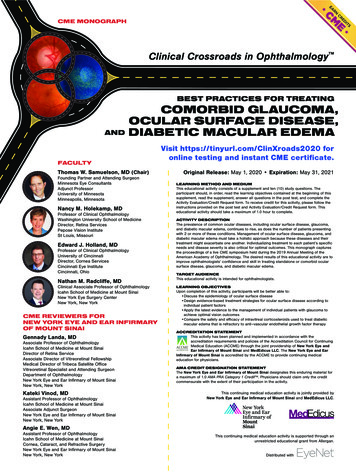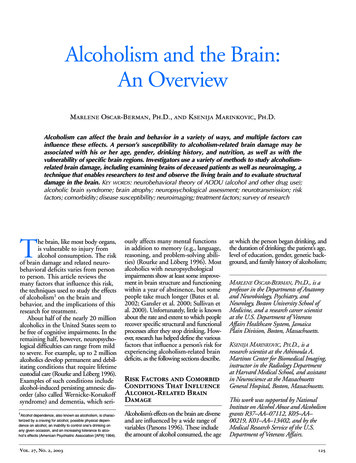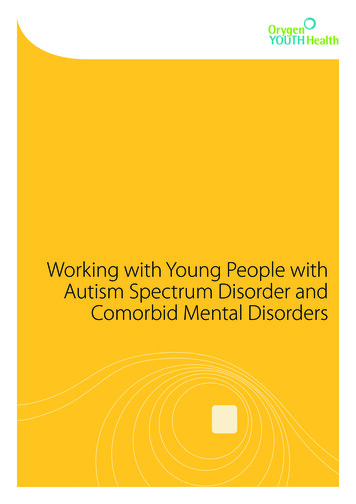
Transcription
CME MONOGRAPHClinical Crossroads in Ophthalmology BEST PRACTICES FOR TREATINGCOMORBID GLAUCOMA,OCULAR SURFACE DISEASE,AND DIABETIC MACULAR EDEMAFACULTYThomas W. Samuelson, MD (Chair)Founding Partner and Attending SurgeonMinnesota Eye ConsultantsAdjunct ProfessorUniversity of MinnesotaMinneapolis, MinnesotaNancy M. Holekamp, MDProfessor of Clinical OphthalmologyWashington University School of MedicineDirector, Retina ServicesPepose Vision InstituteSt Louis, MissouriEdward J. Holland, MDProfessor of Clinical OphthalmologyUniversity of CincinnatiDirector, Cornea ServicesCincinnati Eye InstituteCincinnati, OhioVisit https://tinyurl.com/ClinXroads2020 foronline testing and instant CME certificate.Original Release: May 1, 2020 Expiration: May 31, 2021LEARNING METHOD AND MEDIUMThis educational activity consists of a supplement and ten (10) study questions. Theparticipant should, in order, read the learning objectives contained at the beginning of thissupplement, read the supplement, answer all questions in the post test, and complete theActivity Evaluation/Credit Request form. To receive credit for this activity, please follow theinstructions provided on the post test and Activity Evaluation/Credit Request form. Thiseducational activity should take a maximum of 1.0 hour to complete.ACTIVITY DESCRIPTIONThe prevalence of common ocular diseases, including ocular surface disease, glaucoma,and diabetic macular edema, continues to rise, as does the number of patients presentingwith 2 or more of these conditions. Management of ocular surface disease, glaucoma, anddiabetic macular edema must take a holistic approach because these diseases and theirtreatment might exacerbate one another. Individualizing treatment to each patient’s specificneeds and disease severity is also critical for optimal outcomes. This monograph capturesthe proceedings of a live CME symposium held during the 2019 Annual Meeting of theAmerican Academy of Ophthalmology. The desired results of this educational activity are toimprove ophthalmologists’ confidence and skill in treating standalone or comorbid ocularsurface disease, glaucoma, and diabetic macular edema.TARGET AUDIENCENathan M. Radcliffe, MDThis educational activity is intended for ophthalmologists.Clinical Associate Professor of OphthalmologyIcahn School of Medicine at Mount SinaiNew York Eye Surgery CenterNew York, New YorkLEARNING OBJECTIVESCME REVIEWERS FORNEW YORK EYE AND EAR INFIRMARYOF MOUNT SINAIGennady Landa, MDAssociate Professor of OphthalmologyIcahn School of Medicine at Mount SinaiDirector of Retina ServiceAssociate Director of Vitreoretinal FellowshipMedical Director of Tribeca Satellite OfficeVitreoretinal Specialist and Attending SurgeonDepartment of OphthalmologyNew York Eye and Ear Infirmary of Mount SinaiNew York, New YorkKateki Vinod, MDAssistant Professor of OphthalmologyIcahn School of Medicine at Mount SinaiAssociate Adjunct SurgeonNew York Eye and Ear Infirmary of Mount SinaiNew York, New YorkUpon completion of this activity, participants will be better able to: Discuss the epidemiology of ocular surface disease Design evidence-based treatment strategies for ocular surface disease according toindividual patient factors Apply the latest evidence to the management of individual patients with glaucoma toachieve optimal vision outcomes Compare the safety and efficacy of intravitreal corticosteroids used to treat diabeticmacular edema that is refractory to anti–vascular endothelial growth factor therapyACCREDITATION STATEMENTThis activity has been planned and implemented in accordance with theaccreditation requirements and policies of the Accreditation Council for ContinuingMedical Education (ACCME) through the joint providership of New York Eye andEar Infirmary of Mount Sinai and MedEdicus LLC. The New York Eye and EarInfirmary of Mount Sinai is accredited by the ACCME to provide continuing medicaleducation for physicians.AMA CREDIT DESIGNATION STATEMENTThe New York Eye and Ear Infirmary of Mount Sinai designates this enduring material fora maximum of 1.0 AMA PRA Category 1 Credit . Physicians should claim only the creditcommensurate with the extent of their participation in the activity.This continuing medical education activity is jointly provided byNew York Eye and Ear Infirmary of Mount Sinai and MedEdicus LLC.Angie E. Wen, MDAssistant Professor of OphthalmologyIcahn School of Medicine at Mount SinaiCornea, Cataract, and Refractive SurgeryNew York Eye and Ear Infirmary of Mount SinaiNew York, New YorkThis continuing medical education activity is supported through anunrestricted educational grant from Allergan.Distributed with
GRANTOR STATEMENTThis continuing medical education activity issupported through an unrestricted educational grantfrom Allergan.DISCLOSURE POLICY STATEMENTIt is the policy of New York Eye and Ear Infirmaryof Mount Sinai that the faculty and anyone in aposition to control activity content disclose any realor apparent conflicts of interest relating to the topicsof the educational activity in which they areparticipating. They are also required to disclosediscussions of unlabeled/unapproved uses of drugsor devices during their presentations. New York Eyeand Ear Infirmary of Mount Sinai is committed toproviding its learners with quality CME activities andrelated materials that promote improvements inhealthcare and not the proprietary interests of acommercial interest and, thus, has establishedpolicies and procedures in place that identify andresolve all conflicts of interest prior to the executionor release of its educational activities. Full disclosureof faculty/planners and their commercialrelationships, if any, follows.DISCLOSURESNancy M. Holekamp, MD, had a financial agreementor affiliation during the past year with the followingcommercial interests in the form of Consultant/Advisory Board: Allergan; Clearside Biomedical, Inc;Gemini Therapeutics; Genentech, Inc; Lineage CellTherapeutics, Inc; Novartis PharmaceuticalsCorporation; Regeneron Pharmaceuticals, Inc; andViewpoint Therapeutics; Contracted Research:Gemini Therapeutics; Genentech, Inc; Gyroscope;and Notal Vision, Inc; Honoraria from promotional,advertising or non-CME services received directlyfrom commercial interests or their Agents(eg, Speakers Bureaus): Allergan; Genentech, Inc;Novartis Pharmaceuticals Corporation; RegeneronPharmaceuticals, Inc; and Spark Therapeutics, Inc;Ownership Interest (Stock options, or other holdings,excluding diversified mutual funds): KatalystHealthcares & Life Sciences.Edward J. Holland, MD, had a financial agreementor affiliation during the past year with the followingcommercial interests in the form of Consultant/Advisory Board: Aerie Pharmaceuticals, Inc; Avedro,Inc; Azura Ophthalmics Ltd; Bio-Tissue; BlephEx;BRIM Biotechnology, Inc; Claris Lifesciences Ltd;CorneaGen; CorNeat Vision Ltd; Dompé farmaceuticiSpA; EyePoint Pharmaceuticals; GlaukosCorporation; Hanall Biopharma; Hovione; IanTECH;Imprimis Pharmaceuticals, Inc; Invirsa Inc; IVERICbio; Johnson & Johnson Vision Care, Inc; KalaPharmaceuticals; Katena Products, Inc; Licrieve;Mati Therapeutics, Inc; Merck & Co., Inc; MG Thera;Mintz; Nanowafer, Inc; Novaliq GmbH Germany;Novartis Pharmaceuticals Corporation; OcunexusTherapeutics, Inc; Ocuphire Pharma; OmerosCorporation; Oyster Point Pharma, Inc; Precisebio;Prometic Life Sciences Inc; ReGenTree, LLC; Retear,Inc; Senju Pharmaceutical Co, Ltd; Shire; SightSciences; Silk Technologies Ltd; StuartTherapeutics; Takeda Pharmaceuticals USA, Inc;Tarsus; Tear Film Innovations Inc; TearLabCorporation; TissueTech, Inc; TopiVert Ltd; VomarisInnovations, Inc; W.L. Gore & Associates, Inc; andZeiss; Contracted Research: KeraMed, Inc; MatiTherapeutics, Inc; Novartis PharmaceuticalsCorporation; Omeros Corporation; and SenjuPharmaceuticals; Other (Speaker): NovartisPharmaceuticals Corporation; Omeros Corporation;Senju Pharmaceutical Co, Ltd; and Shire.Nathan M. Radcliffe, MD, had a financial agreementor affiliation during the past year with the followingcommercial interests in the form of Consultant/Advisory Board: Aerie Pharmaceuticals, Inc; Alcon;Allergan; Bausch & Lomb Incorporated; BeaverVisitec International; Carl Zeiss Meditec, Inc;Equinox; Glaukos Corporation; IRIDEX Corporation;Ivantis Inc; Lumenis; New World Medical, Inc;Novartis Pharmaceuticals Corporation; OcularScience; Reichert, Inc; Sight Sciences; TheaPharmaceuticals Limited; and Vialase, Inc.Thomas W. Samuelson, MD, had a financialagreement or affiliation during the past year with thefollowing commercial interests in the form ofConsultant/Advisory Board: Abbott Medical Optics;AcuMEMS, Inc; Aerie Pharmaceuticals, Inc; Akorn,Inc; Alcon; Allergan; AqueSys, Inc; Bausch & LombIncorporated; Beaver-Visitec International; BelkinLaser; Equinox; Glaukos Corporation; Ivantis Inc;Ocuphire Pharma; Polyactiva Pty Ltd; Santen Inc;Shire; Sight Sciences; TearClear; TranscendMedical, Inc; and Valeant; Ownership Interest (Stockoptions, or other holdings, excluding diversifiedmutual funds): Belkin Laser; Equinox; GlaukosCorporation; Ivantis Inc; Ocuphire Pharma; SightSciences; and TearClear.NEW YORK EYE AND EAR INFIRMARYOF MOUNT SINAI PEER REVIEWDISCLOSURESGennady Landa, MD, has no relevant commercialrelationships to disclose.Kateki Vinod, MD, has no relevant commercialrelationships to disclose.Angie E. Wen, MD, has no relevant commercialrelationships to disclose.EDITORIAL SUPPORT DISCLOSURESErika Langsfeld, PhD; Cynthia Tornallyay, RD,MBA, CHCP; Kimberly Corbin, CHCP; BarbaraAubel; and Michelle Ong have no relevantcommercial relationships to disclose.Medical writer: Tony Realini, MD, had a financialagreement or affiliation during the past year with thefollowing commercial interests in the form ofConsultant/Advisory Board: Aerie Pharmaceuticals,Inc; iSTAR; New World Medical, Inc; and Notal Vision.DISCLOSURE ATTESTATIONThe contributing physicians listed above haveattested to the following:1) that the relationships/affiliations noted will notbias or otherwise influence their involvement inthis activity;2) that practice recommendations given relevant tothe companies with whom they have relationships/affiliations will be supported by the best availableevidence or, absent evidence, will be consistentwith generally accepted medical practice; and3) that all reasonable clinical alternatives will bediscussed when making practicerecommendations.OFF-LABEL DISCUSSIONThis CME activity includes discussion of unlabeledand/or investigative uses of drugs. Please refer tothe official prescribing information for each drugdiscussed in this activity for FDA-approved dosing,indications, and warnings.NEW YORK EYE AND EAR INFIRMARYOF MOUNT SINAI PRIVACY &CONFIDENTIALITY POLICIEShttps://www.nyee.edu/education/cmeCME PROVIDER CONTACT INFORMATIONFor questions about this activity, call 212-870-8125.TO OBTAIN AMA PRA CATEGORY 1CREDIT To obtain AMA PRA Category 1 Credit for thisactivity, read the material in its entirety and consultreferenced sources as necessary. Please take thispost test and evaluation online by going tohttps://tinyurl.com/ClinXroads2020. Upon passing,you will receive your certificate immediately. Youmust score 70% or higher to receive credit for thisactivity, and may take the test up to 2 times. Uponregistering and successfully completing the posttest, your certificate will be made available onlineand you can print it or file it.DISCLAIMERThe views and opinions expressed in thiseducational activity are those of the faculty and donot necessarily represent the views of New York Eyeand Ear Infirmary of Mount Sinai, MedEdicus LLC,Allergan, EyeNet, or the American Academy ofOphthalmology.INTRODUCTIONOcular surface disease (OSD) (also known as dry eyedisease [DED]), open-angle glaucoma (OAG), anddiabetic macular edema (DME) are all commonophthalmic conditions, and they frequently coexist inmany patients (Figure 1).1-11 Each condition has itsown distinct signs and symptoms, and each cancontribute to significant vision loss. Not only are therefrequent interactions among DED, OAG, and DME, butthe treatments for each disease can aggravate thesecomorbid conditions.1-7 Developing individualizedtreatment strategies for patients with multipleinteracting ocular conditions represents a significantclinical challenge. In this educational activity, a panelof expert ophthalmologists representing the corneal,glaucoma, and retina specialties will discuss 3 casesof patients with multiple ocular issues, highlighting theconsiderations that must be taken into account whentreating them.30% to 70%of patientswith glaucomahave DED1-7Open-AngleGlaucoma(2.7 millionin theUnited States)8DED(between 5%and 50% of theUS population)9DME(746,000in theUnited States)10Over half of patientswith diabetes have DED11Figure 1. Epidemiology and overlap of common eye diseasesAbbreviations: DED, dry eye disease; DME, diabetic macularedema; IOP, intraocular pressure.EVOLVING LANDSCAPE OFDED TREATMENTDry eye disease is one of the most common ocularconditions, and can produce significant ocularsymptoms of discomfort as well as loss of vision.There are an estimated 55 million Americans withDED,12 of whom up to 38 million may be undiagnosedand untreated.13 Dry eye disease is more common inwomen than in men, and its prevalence increases withage, reaching nearly 8% in men aged 80 years and10% in women aged 75 years.14,15 In patients withglaucoma or diabetes, the prevalence of DED is muchhigher. As many as 30% to 70% of patients withglaucoma have signs and/or symptoms of DED,1-7 andcomorbid DED is associated with poorer glaucomarelated quality of life.6,7 Approximately 50% of patientswith diabetes have concomitant DED,11,16,17 often withabnormal tear breakup time and/or tear secretion.11Dry eye disease is more prevalent in type 2 diabetesthan in type 1 diabetes,16 is significantly associatedwith the duration of diabetes,11 and, as doesglaucoma, adversely affects quality of life.16During the past decade, the significance of DED hasbeen recognized by all ophthalmic specialties as amajor factor in the outcomes of eye diseases treatedboth medically and surgically. Dry eye disease is thecause of postoperative dissatisfaction in 28% ofpatients undergoing LASIK (laser-assisted in situkeratomileusis)18 and in 15% of patients undergoingmultifocal intraocular lens (IOL) implantation.19This CME activity is copyrighted to MedEdicus LLC 2020. All rights reserved. 2032IOP can riseas a result ofsome treatmentsfor DMEFOR INSTANT CME CERTIFICATE PROCESSING, COMPLETE THE POST TEST ONLINE
twice as high in patients using preservedIOP medications vs unpreservedmedications, and the signs and symptomsof DED were correlated with the number ofdrops instilled per day.24 A second studyconfirmed a 2-fold higher prevalence of DEDin patients with glaucoma using preservedvs unpreserved medications and alsodemonstrated that the coexistence of DEDand the use of BAK-containing IOPmedications adversely affected vision-relatedquality of life.4TREATMENT OF DEDFigure 2. Diagnostic process for dry eye disease20Abbreviations: BUT, breakup time; DEQ-5, 5-Item Dry Eye Questionnaire;MGD, meibomian gland dysfunction; NIBUT, noninvasive breakup time;OSDI, Ocular Surface Disease Index; TMH, tear meniscus height.Reprinted from Ocular Surface, 15, Wolffsohn JS, Arita R, Chalmers R, et al, TFOSDEWS II diagnostic methodology report, 539-574, Copyright 2017, with permissionfrom Elsevier.DIAGNOSING DEDThe process of diagnosing DED has been systematically described bythe Tear Film & Ocular Surface Society at its second Dry EyeWorkShop and is outlined in Figure 2.20Once diagnosed, DED can be classified into 2 subtypes: evaporative oraqueous deficiency DED; staging is dependent on the severity ofmeibomian gland dysfunction (MGD) and/or aqueous deficiency.20Evaporative DED arises most commonly in the presence of MGD andcan also occur in patients with abnormal lipid profiles. MGD ischaracterized by hyperkeratinization of the ductal epithelium andincreased meibum viscosity.17 Reduced meibum in the tear film createsan unstable lipid layer, allowing evaporative loss of the aqueous layer.This in turn concentrates electrolytes and inflammatory mediators inthe tear film, resulting in loss of conjunctival goblet cells, furtherperpetuating the DED process. MGD is seen in approximately 50% ofDED cases.21Aqueous-deficient DED is the result of low aqueous tear volume due toinadequate tear production in the lacrimal gland17 and accounts for 10%to 15% of DED cases.21 Aqueous-deficient DED is most commonly agerelated and may be caused in part by ductal obstruction promotinglacrimal gland dysfunction combined with chronic inflammation of thegland.17 The DEQ-5 (5-Item Dry Eye Questionnaire) (available fordownload at png)is a short, 5-item, patient self-assessment of DED symptoms.22Aqueous-deficient DED should raise suspicion for Sjögren syndrome,especially if the DEQ-5 score exceeds 12 and if the patient reports drymouth.17,22 Both DED subtypes may be present to varying degrees withinthe same patient, and is the case approximately 35% of the time.21INTERPLAY OF DED AND GLAUCOMAAs mentioned previously, patients with glaucoma are particularly at riskfor DED. These are typically older patients with higher baseline risk forDED to begin with. Their glaucoma is usually managed with topicalintraocular pressure (IOP)-lowering therapy, often multiple drops perday. This represents a high exposure to medications, of which theirexcipient ingredients—specifically the preservative benzalkoniumchloride (BAK)—have been linked to the DED process.23 A study of morethan 4000 patients demonstrated that ocular surface changes wereHTTPS://TINYURL.COM/CLINXROADS2020Therapy for DED is ideally directed at theprimary underlying pathophysiology.25Aqueous-deficient DED is best managedwith tear replacement, with nonpreservedformulations recommended for frequent useand with gels or ointments for nighttime use.Punctal plugs can be used to potentiate bothnatural and replacement tears. Theinflammatory component of DED can beaddressed with immune-modulating agents,such as cyclosporine or lifitegrast, and withtopical steroids reserved for morerecalcitrant cases or for short-term use toquell inflammatory flares. Patients who are prescribed topical steroidsto treat their DED should be monitored for steroid-induced IOPelevation. Autologous serum tears share several key attributes withnatural tears, including pH, nutrient content, vitamins, fibronectin, andgrowth factors, making this a reasonable therapy for casesunresponsive to other topical therapies.MGD is managed most conservatively with topical lipid-basedlubricants.25 Warm compresses to liquify meibum and facilitate itsexpression is effective but time consuming. Macrolide therapy withtopical azithromycin or oral doxycycline can increase the cellularcollection and release of lipids, decrease the bioactivity of inflammatorycytokines, decrease the bacterial lid flora, and reduce the activity oflipolytic enzymes. Low-dose regimens (eg, doxycycline 50 mg daily)are recommended by the Tear Film & Ocular Surface Society secondDry Eye WorkShop guideline committee. Omega-3 fatty acidsupplementation may also be beneficial in select patients toexogenously increase lipids in the tear film to prevent evaporativeaqueous tear loss.A number of devices provide mechanical manipulation of the lids, withthe goal of expressing meibum and increasing tear lipids.25 Theseinclude thermal treatments that heat the posterior lid and compress thelid to express meibum, microblepharoexfoliation of the eyelid margin tounroof obstructed meibomian gland (MG) orifices, probing of MG ductalorifices, and intense pulsed light treatment to improve meibum flow.Stimulation of the natural tearing reflex is another approach to DEDtherapy. An approved neurostimulation device consists of 2 tips that areinserted into the nostrils and which deliver a low-grade electricalstimulation that promotes tear production.26 In a randomized clinical trial,compared with sham therapy, neurostimulation more effectively promotedmucus secretion via goblet cell degranulation.26 Neurostimulation alsoincreased aqueous tear secretion as evidenced by increased Schirmerscores.27,28 Research into other devices and pharmacologic approachesthat stimulate lacrimal secretion is under way.29CASE 1: COEXISTING DED ANDGLAUCOMAFrom the Files of Edward J. Holland, MDAs discussed, OSD is common among patients with glaucoma becauseof adverse effects sometimes seen with ocular IOP-lowering medication.A common first-line approach is to evaluate whether the topicalmedication regimen can be adjusted. A 65-year-old man reported chronicdecreased vision, burning, and itching in both eyes. He had chronic openangle glaucoma treated with topical latanoprost, timolol, and brimonidinefor many years. On a dry eye questionnaire, he reported fluctuatingSPONSORED SUPPLEMENT3
ABCDr Holland: Agreed. We treated his MGD with omega-3 supplementation,doxycycline 50 mg daily, microblepharoexfoliation and thermal therapy,along with a brief course of loteprednol twice daily to addressunderlying inflammation. Once the ocular surface was healthier, weproceeded with cataract surgery. We implanted a toric IOL to addresshis corneal astigmatism. I considered a multifocal toric IOL to addresshis presbyopia as well, but I recommend multifocal IOLs only when theocular surface is completely normal at the time of IOL calculations toensure optimal power selection and postoperatively so the patient willachieve excellent visual acuity. We were concerned that his surface wasnot at that level, and did not recommend a multifocal IOL. We alsoneeded his surface to be healthy enough to achieve an accurateassessment of the corneal astigmatism to be able to recommend a toricIOL. We were confident of his astigmatism measurements and Itherefore placed a toric IOL. I added a MIGS procedure to give him thebest chance at reducing his medication burden. At last follow-up, hisuncorrected distance VA was 20/20 in both eyes, his ocular comfortwas improved, and his IOP was well maintained using only dailyprostaglandin therapy.DEF&Figure 3. Clinical findings of the patient presented in Case 1. Lissamine green stainingof the conjunctiva (A and B). Fluorescein staining of the cornea (C). Meibomian glandinspissation evident upon expression (D). Meibography image of a normal lid (E) andthat of the patient presented in Case 1 (F).visual acuity (VA), chronically red eyes, and frequent watering of the eyes.On examination, his best-corrected VA (BCVA) was 20/40 in both eyes,with 2 D of corneal astigmatism, IOP was 17 mm Hg OU, and he had3 nuclear sclerotic cataracts. His ocular surface examination revealedMGD with inspissated MGs, 2 lissamine green staining of theconjunctiva, and 4 inferior fluorescein staining of the cornea (Figures3A-3D). His tear film osmolarity was 310 mOsm/L OD and 328 mOsm/LOS, Schirmer test was 12 mm OD and 15 mm OS, and tear breakup timewas 4 seconds OD and 4 seconds OS. Meibography images revealedtruncation and dropout of MGs (Figures 3E and 3F).Dr Holland: This patient was diagnosed with visually significantcataract, chronic OAG, and moderate-to-severe MGD. To what extent ishis glaucoma therapy exacerbating his ocular surface status?Dr Radcliffe: First, we must consider if he is frankly allergic to any ofthe component drugs. The timing of onset or worsening of symptomsrelative to the initiation of therapy with each drug can help clarify this.Second, we should consider cumulative exposure to preservatives.Latanoprost is a once-daily drug, timolol can be dosed once or twicedaily, and brimonidine can be dosed 2 or 3 times daily. He could bereceiving up to 6 drops a day. That is a significant BAK load.Dr Samuelson: Often, BAK intolerance manifests with the second orthird medication added. The patient’s OSD will worsen, and we have todistinguish between an allergy to the recently added medication and athreshold effect in which the cumulative daily dose of BAK is nowenough to become symptomatic.Dr Holland: The patient is motivated to undergo cataract surgery forvisual rehabilitation. What should we consider first?Dr Samuelson: I would wait to perform cataract surgery until after hisMGD has been treated. I would be reluctant to trust IOL calculations—particularly keratometry—obtained while his ocular surface is soirregular. This could affect the surgeon’s ability to achieve a selectedrefractive target.Dr Radcliffe: Once his OSD is under control, cataract surgery has thepotential not only to correct his vision, but the added effect of loweringhis IOP and reducing his medication burden.30 I would also consider aminimally invasive glaucoma surgery (MIGS) procedure at the time of4cataract extraction, with the goal of reducing his future reliance ontopical IOP-lowering therapy.31 Selective laser trabeculoplasty (SLT)may also help reduce his medication burden.32GLAUCOMA: BEYOND MEDICAL THERAPYTopical medical therapy remains the preferred first-line therapy for thereduction of IOP in eyes with OAG and high-risk ocular hypertension.Although efficacy and safety of modern medical therapy for glaucomaare excellent, the chief drawback is poor adherence.33 In recent years,new laser and surgical innovations have challenged the historicalmedications-first approach to glaucoma management. Even thoughmedications will always play a key role in glaucoma therapy, SLT andMIGS procedures are being used far earlier in the treatment paradigmthan ever before.Selective Laser TrabeculoplastySLT was introduced 2 decades ago as a lower-energy form oftrabeculoplasty compared with its predecessor, argon lasertrabeculoplasty.34 With lower energy and little or no thermal damageimparted to the trabecular meshwork (TM),34 SLT—unlike argon lasertrabeculoplasty35-40—is safely repeatable and offers the potential forlong-term glaucoma management when repeated as needed given thatits effect wanes with time.41-49Recently, the LiGHT study evaluated SLT’s role as primary therapy innewly diagnosed and treatment-naïve patients with primary OAG(POAG) or high-risk ocular hypertension.49 In this landmark study,718 subjects were randomized to initial SLT (n 356) or initial medicaltherapy (n 362) and followed for 3 years. A disease- and severityspecific target IOP was established for each eye at enrollment, andtherapy was advanced (repeat SLT or additional medications,respectively) when IOP consistently exceeded target IOP. After 3 years,74.2% of SLT eyes were at target IOP and medication free; most ofthese eyes (76.6%) required only a single SLT treatment. Glaucomaprogression was less common in the SLT group than in the medicationgroup (3.8% vs 5.8%, respectively), cataract surgery was less commonin the SLT group than in the medication group (13 vs 25 eyes,respectively), and trabeculectomy was required only in medicationtreated eyes (0 vs 11 eyes, respectively). Quality of life was comparablebetween groups. In the long term, SLT was found to be more costeffective than medical therapy, confirming similar previous reports.49-51Minimally Invasive Glaucoma SurgeryOn the surgical front, MIGS has transformed the surgical managementof glaucoma. A wide array of MIGS procedures are available that shuntaqueous humor into Schlemm canal, the suprachoroidal space, or thesubconjunctival space (Table). Collectively, these are generally saferprocedures than traditional trabeculectomy or tube-shunt procedures,are easier to perform than filtering surgeries, and offer faster visualrehabilitation.52,53The 2 TM stents—iStent/iStent Inject and Hydrus—bypass the diseasedTM using novel implantable devices and are approved for IOP reductionin eyes with mild-to-moderate POAG at the time of cataract surgery.54,55FOR INSTANT CME CERTIFICATE PROCESSING, COMPLETE THE POST TEST ONLINE
Table. Array of MIGS Procedures, Their Approval Status, and Select AttributesProcedureSchlemm canalDeviceApproved in theUnited StatesBleb FormingTrabectomeYesNoiStent/iStent InjectYes*NoHydrusYes*NoKahook Dual BladeYesNoiTrack(for GATT and ABiC)YesNoOMNI/VISCO360YesNoiStent SupraNoNoSuprachoroidalSubconjunctivalGold shuntNoNoEX-PRESSYesYesXEN Gel StentYesYesPreserFlo/MicroShuntNo†Yes* Approved in the United States only in combination with cataract surgery†Currently in phase 3 clinical trialsAbbreviations: ABiC, ab interno canaloplasty; GATT, gonioscopy-assisted transluminaltrabeculotomy.The iStent Inject—360 μm long and 230 μm wide, with an 80-μm centrallumen—is implanted via an ab interno approach and straddles the TM,facilitating the flow of aqueous humor through the stent into Schlemmcanal.56 In a 2-year phase 3 clinical trial, 75.8% of 380 eyes undergoingcataract surgery with the implant achieved a 20% reduction in meandiurnal IOP compared with 61.9% of 118 eyes undergoing cataractsurgery alone (P .005).56 Mean IOP reductions from unmedicatedbaseline were also greater with the combined procedure than withcataract surgery alone (7.0 vs 5.4 mm Hg; P .001). Stent obstructionoccurred in 6.2% of 386 eyes receiving the combined procedure;otherwise, rates of postoperative inflammation, secondary surgicalinterventions, and posterior vitreous detachments were similarbetween groups.The Hydrus is a flexible, 8-mm-long stent that is also implanted via anab interno approach to deliver aqueous humor into Schlemm canal.57A 12-month prospective randomized trial (COMPARE) compared theHydrus with 2 first-generation iStents as standalone procedures in phakicand pseudophakic eyes with mild-to-moderate POAG.58 The completesurgical success rate (IOP 18 mm Hg on no medications with noreoperations) was 35.6% with Hydrus and 10.5% with iStents (P .001)(Figure 4). IOP reductions were similar between groups, but Hydrus eyeshad greater medication reductions (by 0.6 medications per eye; P .004)and 46.6% of 73 Hydrus eyes were medication free at 12 months vs 24%of 75 eyes receiving iStents (P .004). Device obstruction occurr
Dry eye disease is one of the most common ocular conditions, and can produce significant ocular symptoms of discomfort as well as loss of vision. There are an estimated 55 million Americans with DED,12 of whom up to 38 million may be undiagnosed and untreated.13 Dry eye disease is more common in women than in men, and its prevalence increases with










